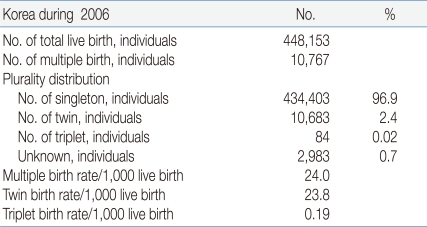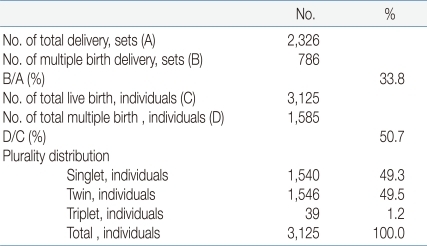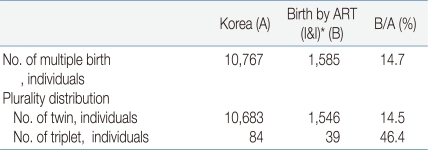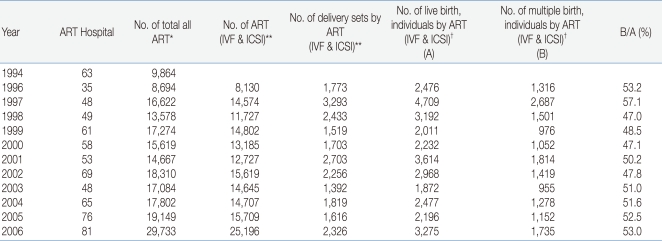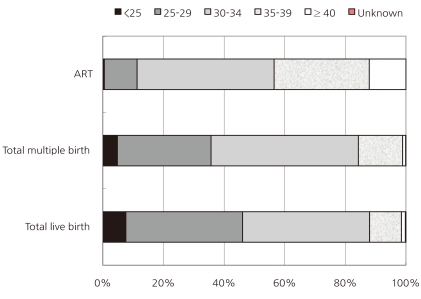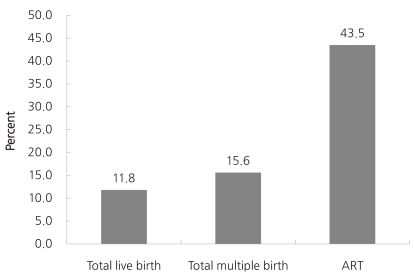Abstract
Purpose
The recent trends of multiple births (MBs) conceived by assisted reproductive technology (ART) in Korea were analyzed as well as the relationship with maternal age, especially advanced maternal age.
Methods
Data were obtained from the Korean Statistical Information Service and annual ART reports from the ART committee of the Korean Society of Obstetrics and Gynecology.
Results
MBs increased from the early 1990s; there was a 275% increase by 2008. The number of total live births was 448,153 and MBs accounted for 10,767; the MB rate was 24.0% in 2006. Among 2,326 deliveries conceived by ART, multiple deliveries accounted for 786 (33.8%). The total number of live births with ART was 3,125 and 1,585 (50.7%) of them were MBs. During 2006, 14.7% of the entire MBs in Korea were associated with ART. The proportion of women of advanced maternal age was much higher in the ART group than in the total live birth group.
Conclusion
MBs in women of advanced maternal age have been increasing in Korea with the use of ART. The results of this study showed that ART was a significant factor associated with the increase in MBs in Korea.
Keywords: Pregnancy, Pregnancy outcome, Newborn, Multiple birth, Reproductive techniques, assisted/statistics, Epidemiology
Introduction
The incidence of multiple births is described as the multiple birth rate (MBR) per 1,000 live births. Over the last 30 years in Korea, the MBR has been maintained at around 10.0 from 1981 to 1990, and then it started to increase from 11.3 in 1992 to 13.2 in 1995, 16.9 in 2000, 20.0 in 2003, 21.7 in 2005 and finally 27.5 in 2008, which is a 275% increase than prior to 19901, 2). Numerous factors have been associated with the increase of multiple births, such as social factors, advanced maternal age, and the introduction of assisted reproductive technology (ART). Advanced maternal age and the use of ART procedures are significant factors associated with the increasing trend of multiple births. Similar trends have been reported in other countries3-5).
The history of ART in Korea begins in 1986 when Chang et.al succeeded in their first attempt of in vitro fertilization (IVF)6). ART became common practice after the Korean Artificial Fertilization Ethics Declaration was made in 1993. The ART committee of the Korean Society of Obstetrics and Gynecology was founded in 1994 and has provided an annual report since then. By July 2009, 139 medical centers have been approved for embryo transfer in Korea7). The time line of the increasing incidence of multiple births parallels the timeline of ART in Korea8). Therefore, ART is a significant factor associated with the increase of multiple births in Korea. The aim of this study was to analyze the recent trends of multiple births conceived by ART in Korea.
Materials and methods
The number of multiple births in 2006, the MBR, the distribution of multiple total live births, and the number of twins and triplets were analyzed using data from the Korean Statistical Information Service9). The MBR was determined for the past 30 years from 1981 to 2008 in Korea.
The data on the number of multiple births conceived by ART was obtained from the annual ART the 2006 report of the ART committee of the Korean Society of Obstetrics and Gynecology7); this report contains the total number of births from ART deliveries, multiple births, MBR, as well as the number and rates of twin and triplet births. These data were collected from 81 ART approved centers in Korea in 2006. ART included in vitro fertilization (IVF) and intracytoplasmic sperm injection (ICSI). ART was evaluated for whether it was a significant factor associated with multiple births by analyzing the incidence of ART associated multiple births among the nationwide total number of multiple births during 2006. The trends in the changes of the number of ART centers, total number of cases of ART procedures, ART associated deliveries, total number of live births, multiple births, and the incidence of multiple births was analyzed based on the data from the annual report from the ART committee of the Korean Society of Obstetrics and Gynecology from 1994 to 20067, 8, 10-18). Data associated with ART is cited from reported references. The use of all data was officially approved by the Korean Society of Obstetrics and Gynecology.
The maternal age among the total live births, total multiple births and the ART groups was compared. By reviewing the distribution of age, whether the mean maternal age of the ART group was advanced could be determined. In the ART group, the maternal age used was the age at the time the ART procedure was performed. Changes in the patterns in the number of ART associated multiple births over the past 10 years were reviewed.
Results
1. Changes of MBR over the past 30 years in Korea
The MBR was maintained at 10.0 from 1981 to 1990. However, it started to increase from the level of 11.3 in 1992 to 13.2 in 1995, 16.9 in 2000, 20.0 in 2003, 21.7 in 2005 and finally 27.5 in 20081, 2). Therefore, the MBR increased from the early 1990s and there was a 275% increase in 2008 compared to the early 1990s. In addition, the doubling time of MBR from 10.0 in 1990 to 20.0 in 2003 took 13 years. However, the time interval was much shorter from the 20.0 in 2003 to 27.5 in 2008, i.e., only five years1, 2).
2. Nationwide multiple birth rate and number of multiple births during 2006 in Korea
The number of total live births was 448,153 and multiple births accounted for 10,767; the MBR was 24.0 during 2006 in Korea. Among the multiple births, 10,683 were twins and 84 were triplets; the twin and triplet birth rates were 23.8 and 0.19, respectively (Table 1).
Table 1.
Nationwide Multiple Births and Distribution of Births in Korea during 2006
From reference 9
3. Multiple births by ART during 2006 in Korea
The total number of ART (IVF and ICSI) associated deliveries during 2006 in Korea was 2,326. Among these ART associated deliveries, there were 786 multiple deliveries (33.8%). The total number of live births from ART was 3,125; there were 1,585 (50.7%) multiple births. The distribution according to the number at delivery was: 1,540 singletons (49.3%), 1,546 twins (49.3%) and 39 triplets (1.2%) (Table 2).
Table 2.
Number of Deliveries, Live Births, and Multiple Births by Assisted Reproductive Technology (ART, IVF, and ICSI)* during 2006 in Korea
*Assisted Reproductive Technology (ART, IVF & ICSI): by procedures of in vitro fertilization (IVF) and intracytoplasmic sperm injection (ICSI). From references 7
4. Incidence of multiple births associated with ART among the total number of multiple births in Korea during 2006
The number of multiple births associated with ART (IVF, ICSI) during 2006 was 1,585; this was 14.7% of the entire multiple births in Korea during 2006. Twin births accounted for 1,546, 14.5% of the twins nationwide, and triplet births accounted for 39, which was 46.4% of the triplet births nationwide during 2006 (Table 3).
Table 3.
Incidence of Multiple Births by Assisted Reproductive Technology (ART, I&I)* among Total Multiple Births Nationwide in Korea during 2006
*Assisted Reproductive Technology (ART, I&I): by procedures of in vitro fertilization (IVF) and intracytoplasmic sperm injection (ICSI). From reference 7
5. Trends in ART induced multiple births over the last 10 years
Table 4 shows several factors associated with the changes in multiple births in couples undergoing ART from 1996 to 2006; including the number of ART procedures, delivery sets, total live births and multiple births. Multiple births accounted for 47-57% of all live births with ART (IVF, ICSI); nearly half of all live births with ART (Table 4).
Table 4.
Number of Deliveries, Live Births, and Multiple Births with Assisted Reproductive Technology in Korea
*All kinds of procedure of assisted reproductive technology including in vitro fertilization (IVF) and intracytoplasmic sperm injection (ICSI)
†Assisted Reproductive Technology (ART, IVF & ICSI): by procedures of in vitro fertilization (IVF) and intracytoplasmic sperm injection (ICSI)
6. Comparison of maternal age with the total live births nationwide, multiple births nationwide and ART in Korea during 2006
A comparison of the maternal age for a) live births nationwide, b) multiple births nationwide and c) ART was carried out. The maternal age was between 30 and 34 in 41.9% of group a), 48.6% of group b) and 45.2% of group c). The maternal age was between 35 and 39 in 10.5% of group a), 14.6% of group b), and 31.4% of group c), and the maternal age was over 40 in 1.3%, 1.0%, and 12.1% of each group, respectively (Fig. 1). A maternal age over 35, was considered advanced maternal age, and was present in 11.8% of group a), 15.6% of group b), and 43.5% of group c). These findings show that the proportion of women with advanced maternal age was much higher in the ART group (Fig. 2).
Fig. 1.
Comparison of maternal age with the total number of live births nationwide, multiple births nationwide, and ART in Korea during 2006. Comparison of the maternal age between a) the total live birth group nationwide, b) the multiple births group nationwide, and c) the ART group in Korea during 2006. The maternal age was between 30 and 34 years in 41.9% of women in group a), 48.6% of women in group b), and 45.2% of women in group c). The maternal age was between 35 and 39 years in 10.5% of women of group a), 14.6% of women of group b), and 31.4% of women of group c). The maternal age was over 40 years in 1.3%, 1.0%, and 12.1% of women of each group, respectively. The maternal age was very high in the ART group.
Fig. 2.
Distribution of advanced maternal age with the total number of live births nationwide, multiple births nationwide, and ART in Korea during 2006. An age over 35 years was considered advanced maternal age; woman of advanced maternal age accounted for 11.8% of total live births nationwide, 15.6% of multiple births nationwide, and 43.5% of ART during 2006 in Korea. Therefore, the proportion of women with advanced maternal age was very high in the ART group.
Discussion
The incidence of spontaneous twinning during pregnancy differs based on geographic location and ethnicity; in general, it is 1/70 in African Americans, 1/88 in Caucasian Americans, 1/86 among the Italians, 1/150 among the Greeks, 1/150 in the Japanese, and 1/300 in the Chinese19). Triplets are estimated to occur in 1 in [86]2 pregnancies and quadruplets in 1 in [86]3 pregnancies in the United States19). The incidence of multiple births has been rapidly increasing.
The MBR in Korea was maintained at around 10.0 from 1981 to 1990. However, it started to increase from 11.3 in 1992 to 13.2 in 1995, 16.9 in 2000, 20.0 in 2003, 21.7 in 2005, and recently 27.5 in 2008. That is a 275% increase from the early 1990s to 20081, 2). In Europe, French researchers reported that the domestic twin pregnancy rate per 1,000 pregnancies was 9.0 in 1972, 14.8 in 1998, and 15.6 in 2008, which is 80% higher than in 19723, 4). In England, the multiple pregnancy rates per 1,000 pregnancies were reported as 9.9 in 1975 and 13.6 in 19945). Blondel3) suggested that the increase was due to advanced maternal age and the widespread use of fertility treatment. Keirse et al20) reported that the increase in premature births was due to an increase of multiple pregnancies associated with advanced maternal age and assisted reproduction procedures. Consistent with these prior studies, the results of this study showed that as the use of ART increased in Korea so did the MBR. Therefore, ART has played an important role in the increase of the MBR in Korea.
The International Committee for Monitoring Assisted Reproductive Technology (ICMART)'s 8th world report analyzed ART practices and results, for the year 2002, from 53 countries by the type of ART performed. The overall frequency of twins was 25.7% per delivery and for triplets it was 2.5% with conventional IVF and ICSI. Although there were variations in availability, the number of babies born worldwide with ART in 2002 was estimated to range between 219,000 and 246,00021). According to the sixth annual European Society of Human Reproduction and Embryology (ESHRE) publication of the European data on ART in 2002, the distribution of singleton, twin and triplet deliveries, for IVF and ICSI combined, was 75.5, 23.2 and 1.3% respectively, for a total multiple delivery rate of 24.5% (data had been collected from 25 countries, 631 clinics reported 324,238 treatment cycles with 122,634 IVF and 135,048 ICSI)22). Their results during 2005, showed singleton, twin and triplet deliveries, after IVF and ICSI, were 78.2%, 21.0% and 0.8%, respectively, for a total multiple delivery rate of 21.8% (data had been collected from 30 countries, 923 clinics reported 418,111 treatment cycles including 118,074 IVF and 203,329 ICSI)23). A nationwide ART review in the United States described 138,198 cases of ART reported to the CDC in one year, during 2006. There were 41,343 deliveries and 54,656 neonates were born. Among these newborns, 48% of the neonates were from multiple births. That is approximately 1% of the total number of newborns in the US were from ART assisted pregnancies in 2006. The number of multiple births from ART was 18% of the total number of multiple births24). Sunderam et al24) suggested that neonates from ART pregnancies should be managed closely because they are at higher risk for preterm delivery or low birth weight due to multiple births.
In this study, there were 448,153 live births and 10,767 multiple births for a MBR of 24.0 for the year 2006 in Korea. The number of all types of ART procedures was 29,733 (for IVF and ICSI it was 25,196), and the number of delivery sets and live births IVF and ICSI were 2,326 and 3,275 in 2006, respectively. There were 1,546 twins and 39 triplets in 2006. Multiple births among ART (IVF and ICSI) associated births from 1996 to 2006 were 47.0 and 57.1%, that is around half of all ART associated births were multiple births. These results are consistent with the US statistics of 48%, as described above. Approximately 15% of all multiple births were ART associated multiple births (1,585 ART related multiple birth individuals among entire 10,767 multiple birth individuals, 14.7%). It is assumed that the multiple births associated with ART accounts for a large portion of the total multiple births in Korea. This is slightly lower than in of US, 18%, but similar.
Another important factor associated with multiple births is advanced maternal age. The maternal age of pregnancies with multiple births is usually more advanced. Because most women that undergo ART have fertility problems, they are usually of advanced maternal age. The twin and triplet pregnancy rate in women of advanced maternal age over 40 has been reported to be 11.0% and 1.1% respectively in Europe23). Blondel et al3) surveyed the relationship between advanced maternal age and multiple births and demonstrated that the widespread use of fertility treatment was a significant factor associated with advanced maternal age. In this study, the distribution of maternal age in Korea during 2006 showed that the age between 30 and 34 was 41.9% in a) nationwide for the total number of live births; it was 48.6% in b) nationwide for the multiple births and 45.2% in c) the ART group. For maternal age between 35 and 39 it was 10.5% in group a), 14.6% in group b), and 31.4% in group c); for maternal age over 40 it was 1.3%, 1.0%, and 12.1%, respectively (Fig.2). A maternal age over 35, is considered advanced maternal age, which was present in 11.8% of group a), 15.6%, of group b), and 43.5% of group c). Therefore, the proportion of women with advanced maternal age was much higher in the ART group. In conclusion, the results of this study show that ART is an important causative factor of multiple births. The advanced maternal age of the women that undergo ART is also an important factor associated with multiple births. ART poses a major risk for multiple births associated with adverse maternal and infant outcomes. To minimize the adverse maternal and infant outcomes associated with ART treatment, ongoing optimal managements for multiple pregnancy and birth should be continued and strengthened.
Acknowledgements
We would like to thank the ART committee under the Korean Society of Obstetrics and Gynecology who organized and offered ART related data from annual reports of current status of assisted reproductive technology in Korea. Lastly, I owe my deepest gratitude to the corresponding author of those articles, Young Min Choi, M.D.(Department of Obstetrics & Gynecology, Seoul National University School of Medicine, Seoul, Korea), for his generous cooperation.
References
- 1.Hur YM, Kwon JS. Changes in twinning rates in South Korea: 1981-2002. Twin Res Hum Genet. 2005;8:76–79. doi: 10.1375/1832427053435445. [DOI] [PubMed] [Google Scholar]
- 2.Choi SH, Park YS, Shim KS, Choi YS, Chang JY, Hahn WH, et al. Recent trend of the incidence of multiple births and its consequences on perinatal problems in Korea. J Korean Med Sci. 2010;25:1191–1196. doi: 10.3346/jkms.2010.25.8.1191. [DOI] [PMC free article] [PubMed] [Google Scholar]
- 3.Blondel B, Kaminski M. The increase in multiple births and its consequences on perinatal health. J Gynecol Obstet Biol Reprod. 2002;31:725–740. [PubMed] [Google Scholar]
- 4.Blondel B. Increase in twin maternities and consequences on health. J Gynecol Obstet Biol Reprod. 2009;38:S7–S17. doi: 10.1016/S0368-2315(09)73555-0. [DOI] [PubMed] [Google Scholar]
- 5.Dunn A, Macfarlane A. Recent trends in the incidence of multiple births and associated mortality in England and Wales. Arch Dis Child Fetal Neonatal Ed. 1996;75:F10–F19. doi: 10.1136/fn.75.1.f10. [DOI] [PMC free article] [PubMed] [Google Scholar]
- 6.Chang YS, Lee JY, Moon SY, Kim JG. Pregnancy and its outcome by in vitro fertilization of human oocytes and embryo transfer. Korean J Obstet Gynecol. 1986;29:354–361. [Google Scholar]
- 7.ART committee, Korean Society of Obstetrics and Gynecology. Current status of assisted reproductive technology in Korea for 2006. Korean J Obstet Gynecol. 2009;52:1212–1238. [Google Scholar]
- 8.ART committee, Korean Society of Obstetrics and Gynecology. Current status of assisted reproductive technology in Korea for 1994. Korean J Obstet Gynecol. 1998;41:236–253. [Google Scholar]
- 9.Korean Statistical Information Service. Available from: URL: http://www.kosis.kr/
- 10.ART committee, Korean Society of Obstetrics and Gynecology. Current status of assisted reproductive technology in Korea for 1997. Korean J Obstet Gynecol. 1999;42:2151–2175. [Google Scholar]
- 11.ART committee, Korean Society of Obstetrics and Gynecology. Current status of assisted reproductive technology in Korea for 1998. Korean J Obstet Gynecol. 2001;44:1883–1899. [Google Scholar]
- 12.ART committee, Korean Society of Obstetrics and Gynecology. Current status of assisted reproductive technology in Korea for 1999. Korean J Obstet Gynecol. 2002;45:1700–1717. [Google Scholar]
- 13.ART committee, Korean Society of Obstetrics and Gynecology. Current status of assisted reproductive technology in Korea for 2000. Korean J Obstet Gynecol. 2003;46:1888–1904. doi: 10.5468/ogs.2013.56.6.353. [DOI] [PMC free article] [PubMed] [Google Scholar]
- 14.ART committee, Korean Society of Obstetrics and Gynecology. Current status of assisted reproductive technology in Korea for 2001. Korean J Obstet Gynecol. 2004;47:2285–2302. doi: 10.5468/ogs.2013.56.6.353. [DOI] [PMC free article] [PubMed] [Google Scholar]
- 15.ART committee, Korean Society of Obstetrics and Gynecology. Current status of assisted reproductive technology in Korea for 2002. Korean J Obstet Gynecol. 2005;48:2777–2796. [Google Scholar]
- 16.ART committee, Korean Society of Obstetrics and Gynecology. Current status of assisted reproductive technology in Korea for 2003. Korean J Obstet Gynecol. 2006;49:2479–2496. [Google Scholar]
- 17.ART committee, Korean Society of Obstetrics and Gynecology. Current status of assisted reproductive technology in Korea for 2004. Korean J Obstet Gynecol. 2007;50:1615–1639. doi: 10.5468/ogs.2013.56.6.353. [DOI] [PMC free article] [PubMed] [Google Scholar]
- 18.ART committee, Korean Society of Obstetrics and Gynecology. Current status of assisted reproductive technology in Korea for 2005. Korean J Obstet Gynecol. 2008;51:1421–1447. [Google Scholar]
- 19.Stoll JB, Adams-Chapman I. Multiple gestational pregnancies. In: Kliegman RM, Behrman RE, Jenson HB, Stanton BF, editors. Nelson textbook of pediatrics. 18th ed. Philadelphia: Saunder Elsevier; 2007. pp. 699–700. [Google Scholar]
- 20.Keirse MJ, Hanssens M, Devlieger H. Trends in preterm births in Flanders, Belgium, from 1991 to 2002. Paediatr Perinat Epidemiol. 2009;23:522–532. doi: 10.1111/j.1365-3016.2009.01067.x. [DOI] [PubMed] [Google Scholar]
- 21.International Committee for Monitoring Assisted Reproductive Technology. de Mouzon J, Lancaster P, Nygren KG, Sullivan E, Zegers-Hochschild F, Mansour R, et al. World collaborative report on Assisted Reproductive Technology, 2002. Hum Reprod. 2009;24:2310–2320. doi: 10.1093/humrep/dep098. [DOI] [PubMed] [Google Scholar]
- 22.European IVF-monitoring programme (EIM) for the European Society of Human Reproduction and Embryology (ESHRE) Andersen AN, Gianaroli L, Felberbaum R, de Mouzon J, Nygren KG. Assisted reproductive technology in Europe, 2002. Results generated from European registers by ESHRE. Hum Reprod. 2006;21:1680–1697. doi: 10.1093/humrep/del075. [DOI] [PubMed] [Google Scholar]
- 23.Nyboe Andersen A, Goossens V, Bhattacharya S, Ferraretti AP, Kupka MS, de Mouzon J, et al. European IVF-monitoring (EIM) Consortium, for the European Society of Human Reproduction and Embryology (ESHRE) Assisted reproductive technology and intrauterine inseminations in Europe, 2005: results generated from European registers by ESHRE: ESHRE. The European IVF Monitoring Programme (EIM), for the European Society of Human Reproduction and Embryology (ESHRE) Hum Reprod. 2009;24:1267–1287. doi: 10.1093/humrep/dep035. [DOI] [PubMed] [Google Scholar]
- 24.Sunderam S, Chang J, Flowers L, Kulkarni A, Sentelle G, Jeng G, et al. Centers for Disease Control and Prevention (CDC) Assisted reproductive technology surveillance--United States, 2006. MMWR Surveill Summ. 2009;58:1–2. [PubMed] [Google Scholar]



